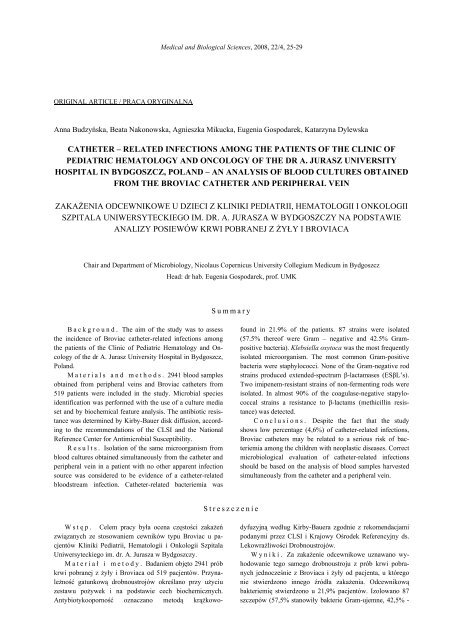medical and biological sciences - Collegium Medicum - Uniwersytet ...
medical and biological sciences - Collegium Medicum - Uniwersytet ...
medical and biological sciences - Collegium Medicum - Uniwersytet ...
You also want an ePaper? Increase the reach of your titles
YUMPU automatically turns print PDFs into web optimized ePapers that Google loves.
Medical <strong>and</strong> Biological Sciences, 2008, 22/4, 25-29ORIGINAL ARTICLE / PRACA ORYGINALNAAnna Budzyńska, Beata Nakonowska, Agnieszka Mikucka, Eugenia Gospodarek, Katarzyna DylewskaCATHETER – RELATED INFECTIONS AMONG THE PATIENTS OF THE CLINIC OFPEDIATRIC HEMATOLOGY AND ONCOLOGY OF THE DR A. JURASZ UNIVERSITYHOSPITAL IN BYDGOSZCZ, POLAND – AN ANALYSIS OF BLOOD CULTURES OBTAINEDFROM THE BROVIAC CATHETER AND PERIPHERAL VEINZAKAŻENIA ODCEWNIKOWE U DZIECI Z KLINIKI PEDIATRII, HEMATOLOGII I ONKOLOGIISZPITALA UNIWERSYTECKIEGO IM. DR. A. JURASZA W BYDGOSZCZY NA PODSTAWIEANALIZY POSIEWÓW KRWI POBRANEJ Z ŻYŁY I BROVIACAChair <strong>and</strong> Department of Microbiology, Nicolaus Copernicus University <strong>Collegium</strong> <strong>Medicum</strong> in BydgoszczHead: dr hab. Eugenia Gospodarek, prof. UMKSummaryB a c k g r o u n d . The aim of the study was to assessthe incidence of Broviac catheter-related infections amongthe patients of the Clinic of Pediatric Hematology <strong>and</strong> Oncologyof the dr A. Jurasz University Hospital in Bydgoszcz,Pol<strong>and</strong>.M a t e r i a l s a n d m e t h o d s . 2941 blood samplesobtained from peripheral veins <strong>and</strong> Broviac catheters from519 patients were included in the study. Microbial speciesidentification was performed with the use of a culture mediaset <strong>and</strong> by biochemical feature analysis. The antibiotic resistancewas determined by Kirby-Bauer disk diffusion, accordingto the recommendations of the CLSI <strong>and</strong> the NationalReference Center for Antimicrobial Susceptibility.R e s u l t s . Isolation of the same microorganism fromblood cultures obtained simultaneously from the catheter <strong>and</strong>peripheral vein in a patient with no other apparent infectionsource was considered to be evidence of a catheter-relatedbloodstream infection. Catheter-related bacteriemia wasfound in 21.9% of the patients. 87 strains were isolated(57.5% thereof were Gram – negative <strong>and</strong> 42.5% Grampositivebacteria). Klebsiella oxytoca was the most frequentlyisolated microorganism. The most common Gram-positivebacteria were staphylococci. None of the Gram-negative rodstrains produced extended-spectrum β-lactamases (ESβL’s).Two imipenem-resistant strains of non-fermenting rods wereisolated. In almost 90% of the coagulase-negative stapylococcalstrains a resistance to β-lactams (methicillin resistance)was detected.Conclusions. Despite the fact that the studyshows low percentage (4,6%) of catheter-related infections,Broviac catheters may be related to a serious risk of bacteriemiaamong the children with neoplastic diseases. Correctmicro<strong>biological</strong> evaluation of catheter-related infectionsshould be based on the analysis of blood samples harvestedsimultaneously from the catheter <strong>and</strong> a peripheral vein.StreszczenieWstę p . Celem pracy była ocena częstości zakażeńzwiązanych ze stosowaniem cewników typu Broviac u pacjentówKliniki Pediatrii, Hematologii i Onkologii SzpitalaUniwersyteckiego im. dr. A. Jurasza w Bydgoszczy.Materiał i m e t o d y . Badaniem objęto 2941 próbkrwi pobranej z żyły i Broviaca od 519 pacjentów. Przynależnośćgatunkową drobnoustrojów określano przy użyciuzestawu pożywek i na podstawie cech biochemicznych.Antybiotykooporność oznaczano metodą krążkowodyfuzyjnąwedług Kirby-Bauera zgodnie z rekomendacjamipodanymi przez CLSI i Krajowy Ośrodek Referencyjny ds.Lekowrażliwości Drobnoustrojów.Wyniki. Za zakażenie odcewnikowe uznawano wyhodowanietego samego drobnoustroju z prób krwi pobranychjednocześnie z Broviaca i żyły od pacjenta, u któregonie stwierdzono innego źródła zakażenia. Odcewnikowąbakteriemię stwierdzono u 21,9% pacjentów. Izolowano 87szczepów (57,5% stanowiły bakterie Gram-ujemne, 42,5% -
















